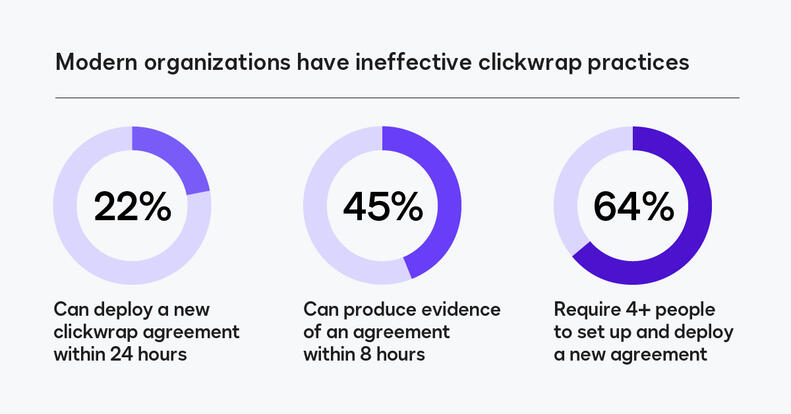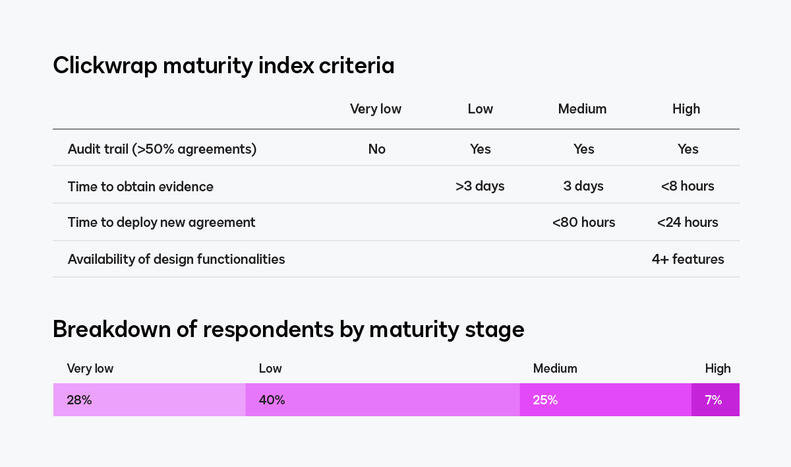How to Mitigate Legal Risk with Effective Clickwrap Solutions
Companies around the world are increasingly using clickwrap solutions to capture legally-binding acceptance of agreements while delivering a seamless customer experience. These tools allow companies to present a series of necessary standard terms—such as terms and conditions, privacy policies and disclosures—that a customer can accept with a single click. In a business landscape that involves ever-changing data rights and other customer protections, it’s crucial for organizations to mitigate legal risk while making it easy for customers to agree to standard terms. Often, the easiest way to achieve those goals is to implement a robust clickwrap solution.
To explore the way modern companies are using this technology, Frost & Sullivan conducted an in-depth study of clickwrap usage involving more than 300 agreement decision makers in the United States and Europe. This post will share some of the highlights of that study, but there’s more in-depth analysis of the findings in Frost & Sullivan’s complete study.
The research shines a light on the technology utilized to conduct clickwrap transactions today, the overall satisfaction and success rates with their clickwrap solutions and how the maturity of their clickwrap solutions affect business outcomes. An important piece of the study separated respondents into four key stages of clickwrap maturity, examining how the maturity of their clickwrap solution impacts business performance and legal risk mitigation. Due to a number of different factors, nearly three out of four organizations are considering a new clickwrap solution in 2021.
The need for robust clickwrap solutions
The primary business reasons companies adopt clickwrap solutions are to improve customer experience, increase revenue and protect intellectual property. Clickwrap technologies are useful to achieve all these goals while executing routine customer interactions, such as creating a new online account or completing an online checkout flow. According to the study, today’s businesses seek to use clickwrap solutions to:
- Capture evidence of consent to terms and conditions
- Manage risk/compliance with regulations
- Deploy policy updates quickly
- Notify users of those updates
However, not all clickwrap solutions are able to actually document evidence of that consent, which can be costly and detrimental to the organization, especially in the event of a customer dispute. These penalties are common and failure to prepare for legal challenges can result in legal fees and fines far exceeding the cost of upfront compliance. In fact, 83% of survey respondents reported experiencing clickwrap disputes in the last 5 years, with penalties from $50,000 to $5 million.

Clickwraps are increasingly a focus of customer consent efforts at many companies. Half of all organizations update their agreements at least two to three times a year. With all that change, 70% of those organizations are still just using an email or a website banner to notify users of updates to agreement terms, which increases legal risk since there’s no way to capture evidence of consent to the updated terms.
Measuring maturity of clickwrap solutions
To better understand how respondents fared relative to each other, Frost & Sullivan established a set of criteria to measure the overall maturity of clickwrap solutions and how that impacts legal risk and costs to the business. That index is based on a number of criteria, including the availability of an audit trail, speed of obtaining evidence, time required to deploy new agreements and robustness of design functionalities.
What the researchers found was that most companies still aren’t very mature in their clickwrap capabilities. More than two-thirds of respondents were either low maturity or worse and only 7% were considered high maturity. Here’s a brief overview of the clickwrap maturity index criteria:

The costs of complacency for ineffective, low-maturity clickwrap solutions
One of the overarching findings of the report was that having a clickwrap solution that simply includes a lot of features doesn’t necessarily translate to maturity or efficacy. A common theme across companies with a lower maturity clickwrap solution is the belief that their tools are more effective than their performance indicates; however, their solutions are less efficient, leading to more legal risks and higher costs.
For example, consider the need to produce evidence of customer consent. This might seem like a routine business process, but 70% of survey respondents identify capturing evidence of customers consent as a challenge. More than two-thirds of low-maturity companies take more than two days to over a month to produce evidence of a clickwrap agreement. That’s simply far too long to effectively take action against a legal consumer dispute.
Another big difference between low- and high-maturity organizations is the consideration given to legal threats. Companies with ineffective clickwrap solutions view legal disputes as a less serious risk than their more advanced counterparts. Because of that nonchalance, more than half of companies with lower clickwrap maturity encounter disputes on at least a regular basis. Not only are legal disputes more common for low-maturity companies, but the fines paid out are also more costly than those encountered by high-maturity companies.

To add to the costs of legal disputes, companies with ineffective clickwrap solutions also require more resources to perform standard agreement actions, which creates an opportunity cost. These organizations take three times longer to deploy new clickwrap agreements and require more employees to perform that task. Instead of optimizing a single central clickwrap solution, companies are managing an average of three separate solutions for their clickwrap solutions, which can be costly and strain resources.
How to improve the effectiveness of your clickwrap solution
There are multiple benefits that come from improving the maturity and effectiveness of your clickwrap solution. For example, better clickwraps will mitigate exposure to legal risk, reduce user disputes and save money resolving them. In addition, it will reduce actual and opportunity costs for your organization, allowing you to allocate resources to other strategic company initiatives. Here are a few recommendations from the Frost & Sullivan researchers to optimize your clickwrap processes:
- Standardize on a single, best-in-class platform
- Invest in third-party solutions that are easy to deploy and use without IT involvement
- Establish a detailed and robust audit trail with versioning and design capabilities (focus on speed and ease of use with these capabilities)
- Engage your legal department early in the process and get their buy-in
To learn more about the impact of clickwrap technology and plan out steps your organization can take to improve clickwrap maturity, read Frost & Sullivan’s full report.
If your business is looking for a modern clickwrap solution, DocuSign Click is a simple-to-deploy tool that makes capturing customer consent to standard terms as easy as a single click.